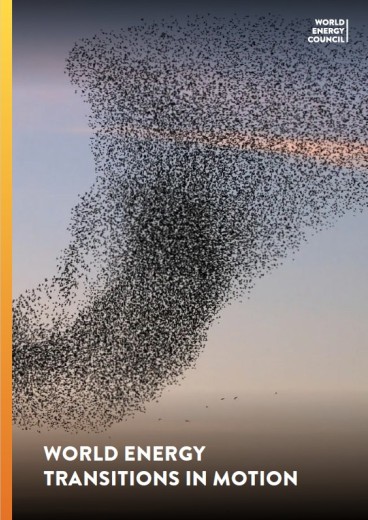World Energy Council chief highlights Chile's energy storage regulations push
This article was originally published in Bnamericas. Read the original article here
Chile is advancing apace along the energy transition highway, even taking a vanguard position in areas such as energy storage rules and regulations. And via the Chile committee of the World Energy Council, the country shares its experiences with other nations. World Energy Council secretary general and CEO Angela Wilkinson recently visited Chile for the 10th anniversary of the founding of the local committee, which comprises members from the public and private sectors and academia. BNamericas met with Wilkinson to find out more and discuss both local and global issues. The mission of the London-headquartered Council – established over 100 years ago – is to promote “the sustainable supply and use of energy for the greatest benefit of all people.” In Panama in October, the Council is due to hold its annual gathering of world energy leaders, dubbed World Energy Week.
This is the first of a two-part interview with Angela Wilkinson.
BNamericas: What can you tell us about the Council’s Chilean presence?
Wilkinson: The Chilean member committee has created an effective and permanent multi-stakeholder platform for discussing energy issues, outlooks, problems, challenges, solutions. And it’s quite remarkable the way the ecosystem is really represented in Chile. It’s one of our standout role model member committees in the world, because they’ve done so much work getting beyond the classic energy players and bringing in the broader ecosystem to have these conversations. And they’ve set up programs. They’ve got a vibrant future energy leaders program starting up. They’ve got a women-in-energy program. They’ve got a fantastic kids-in-energy program.And although a lot of people think in a world of trillion-dollar deals that this is all trivial stuff, actually it depends what your narrative is. And our narrative is that energy is for all of us. And it’s the usefulness of energy that we’re trying to get the conversation about.
It’s not about kilowatt hours. It’s about what energy delivers in people’s lives. And so, if you want to have that conversation, you’ve got to get out of the Wall Street jargon of big deals and kilowatt hours and ask people what do they want energy for? What do they need energy for? Are they getting the necessary service from energy? And then what do we do about it? Chile has such an agile and open mindset to learning and showcasing things with other parts of the world. So, what we’re seeing from Chile is regulatory innovation around storage that is leading in the world. The member committee brings the Chilean progress into the world and the voice of Chile into the World Energy Council. And I think that’s remarkable.
BNamericas: Can you tell us a little about the global focus of the Council?
Wilkinson: For 100 years we’ve been a visionary and pragmatic leadership community. We don’t want the world to be worse, the future to be worse, or just the same as it is. We think there are new and better possibilities and energy all the time. So that’s the visionary bit. And the pragmatic bit is that it’s not enough to inspire. You have to focus on the how to do it, not just the ideal of what you want to achieve. So that’s what we look at. We look at how we get knowledge exchange and best practice exchange across different regions, different sectors, different levels of society. It’s not talking in terms of gigawatts and the technocratic jargon that comes from energy; it’s actually having a conversation with each other and shifting that conversation away from all this supply-centric stuff that’s going on. Can we stop supply? Can we substitute supply? Can we get more supply? Well, where’s the rest of the system? Where are the users? Where are the demands? Where are the needs? Where is the value in use that is going to give your affordability that tells you whether you can pay for the supply? So, my sense is that what we’ve been trying to do in the last six years is shift the conversation from a supply-centric leadership mindset into a user-centric system or change process. And so I think you have to be a bit visionary because you’re framing it differently. What we want are practical solutions.
BNamericas: What’s the state of play regarding the global energy transition? What are we doing well? What do we need to improve?
Wilkinson: I always start by asking people would they mind if we just take a step back. There isn’t the global energy transition: there are multiple energy additions and transitions happening in all regions of the world. So, if we don’t put the ‘s’ on it becomes problematic to start with. And the difference depends on how you want to frame the challenge. If you want to frame it only in CO2 emissions terms, then what we’ve managed to do since the Kyoto Protocol [which entered into force in 2005] is prevent adding emissions from the additional supply of energy we’ve put into the system. But we have done very little in terms of decarbonizing what existed before. So, what we’ve done is we have had relative decarbonization, not absolute decarbonization. So, in terms of transitions though, it’s not just a technology transition that’s going on. It’s not all about energy. We have a transition to a digital future. So we’re looking at how do we meet demand for energy abundance, the energy for emerging and developing economies, for better lives, dignity, and also the growth of digital. And so what we’re really facing at the moment is what we might call an electrification super cycle, which is being buffered by geopolitical storms.
And we have energy deficits underestimated and growing because the basic electrification measure really doesn’t do justice to the deficit situation. We’ve got Mother Nature starting to shuffle the deck. We’ve had two blackouts in Chile in the last year. So, we might want to think who’s really holding the trump card. We’ve got climate impact biting. And we’ve got basically a very little workforce to deliver the life force of energy for the next 100 years. We have a gap on the skills and talent side. So that’s what I would say is generally the situation.
BNamericas: How do you see Latin America’s role in global energy transitions? How can the region contribute?
Wilkinson: I think the starting point is that there’s no one size fits all. But there’s no time to waste in reinventing wheels. So how do we understand the implications of regional diversity? And how do we help different places and people learn with, and from, each other? That’s what the Council exists for. So, when I come to Latin America, I mean, the difference here is just the phenomenal space, resources. There’s a lot going for Latin America, in terms of the ability to develop energy resources, the ability to develop supply chains. What’s lacking here is always investment because of the structural inequalities. So how does the region attract investment? Chile’s been quite successful in terms of the ability to develop energy resources, the ability to develop supply chains. What’s lacking here is always investment because of the structural inequalities. So how does the region attract investment? Chile’s been quite successful because it has table regulatory frameworks and they’re progressive and forward-looking. Argentina has suffered from a lack of investment in its energy system, and it has had, I think what I heard, what the horrendous statistic that poverty was at 50% in the first half of last year. And so, the trade deficit’s a big issue. And that affects the investment. And for the investment to come into energy, you need a regulatory framework. And so you have to work on that stabilization. Latin America’s not a single space. Brazil is a region in itself. So when you’re talking about Argentina, Brazil, you’re talking about Chile, you’re talking about these different countries, you have to think there are multiple transitions and additions here as well/ And there’s learning everywhere. There are big bright spots.
What Brazil’s doing with the US$30bn investment in transition, what Chile has been doing around the regulatory innovation, around storage, what Columbia has been doing about streamlining licensing and permitting. So everywhere you go, you can find bright spots. And it’s important that the world learns with Latin America. There’s a mentality issue here, regionally. I’ve asked people, what’s the story that’s going on? They’ve told me, “Well, basically, we still look at Europe as the parent, and we’re trying to please the parent.” So there’s sort of that instability of, “we’re standing on our own two feet, but we want somebody to tell us we’re doing a good job.”




